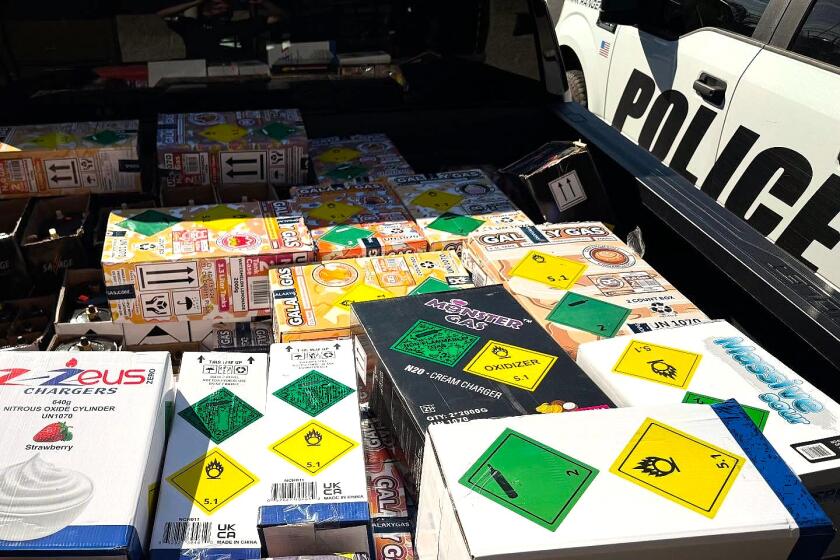Laguna Beach to take sweeping measures for fire preparedness, $23 million authorized for mitigation efforts
- Share via
Laguna Beach will move ahead with sweeping plans to fortify the city in the face of severe fire risk and earmark nearly $23 million toward wildfire mitigation efforts over the next two years following a unanimous City Council vote this week.
Over that time, the city will expand outreach and emergency alerts, underground power lines along Coast Highway and refine local evacuation plans. Laguna Beach also will expand its efforts to remove dry brush and vegetation that provide fuel for fires — with the goal of clearing the entire city within 10 years.
Tuesday’s council vote also approved creating a new city position, defensible space inspector, to oversee brush removal and serve as a fire-preparedness resource for the community.
The decision sets into motion a series of 29 short-term goals recommended by Mayor Bob Whalen’s Wildfire Mitigation and Fire Safety Subcommittee. The city has already appropriated about $16 million for those measures, including $10 million in undergrounding credits purchased from other cities, $4.7 million from a state grant and almost $1.3 million of “potential water district funding.”
Tuesday’s vote approved allocating the remaining $6.9 million from various city funds, redirected pension contributions and the annual hotel tax.
Council members also conceptually approved 16 other medium- and long-term goals, but will decide how to fund the estimated $145 million needed to pay for those recommendations at their next two-year budget hearing in 2021.
Many in the audience at Tuesday’s meeting urged the council to support the goals outlined in the report. Several recounted memories from recent fires — including November’s Camp fire that devastated the town of Paradise, the Woolsey fire in Malibu, and last summer’s Aliso fire that broke out below Laguna’s Top of the World neighborhood.
“The entire town needs to be safe, viable and resilient,” said Sonny Myers, director of the city’s community emergency response team. “If we have a Paradise-style incident and it blows over in one night, we’re going to have 23,000 homeless people — and we’re complaining about 50 of them in town.”
The 1993 fire in Laguna Beach that decimated 441 homes and consumed 14,000 acres also was at the top of many people’s minds, including Councilwoman Toni Iseman.
She recalled preparing to leave home when she noticed a truck blocking her driveway. She watched a line of cars, packed to the gills with people’s life possessions, inch down her street. When the truck finally moved out of the way, she was faced with a choice.
“I had to make a decision whether I wanted to burn in my home or burn in my car,” Iseman said. “That’s the kind of profound nature of this disaster.”
Though Mayor Pro Tem Steve Dicterow and Iseman ultimately voted for the measures, they shared some in the community’s concerns about allocating such substantial funds without more time to consider the plans. Dicterow said he felt “rushed.”
The report was released two weeks ago.
Iseman suggested approving the report’s recommendations without the most-expensive items and sending subcommittee members to Washington D.C. to lobby Congress for more funding. She pointed out that two of the city’s representatives, U.S. Rep. Harley Rouda and state Assemblywoman Cottie Petrie-Norris, live in Laguna Beach.
“We’re not doing this just for the citizens of Laguna Beach,” Iseman said. “We’re doing this because it’s a destination for so many people.”
Whalen responded that the city will have to seek state and federal support for the report’s $138.5 million in unfunded long-term goals. The report recommends several potential funding sources for the remaining $9.4 million in medium-term goals, such as raising parking fees or applying for more grants.
The council’s vote followed an hour-long presentation outlining the research of the Wildfire Mitigation and Fire Safety Subcommittee, which was convened in January to assess and research how to mitigate the city’s wildfire risk, as well as develop a plan with funding sources.
The subcommittee presented the circumstances that uniquely position Laguna to be an especially risky place for a fire: 16,000 acres of open terrain, only three roadways out of town and an estimated summer population of 6 million visitors, in addition to 23,000 residents.
As part of its seven months of research, the subcommittee traveled to Paradise and heard from emergency officials about the Woolsey fire. Paradise and Malibu both have potentially dangerous wildfire conditions that resemble Laguna’s.
“The challenges they faced were not only eye-opening, but chilling,” said subcommittee member Police Capt. Jeff Calvert, referring to Paradise.
All the latest on Orange County from Orange County.
Get our free TimesOC newsletter.
You may occasionally receive promotional content from the Daily Pilot.




